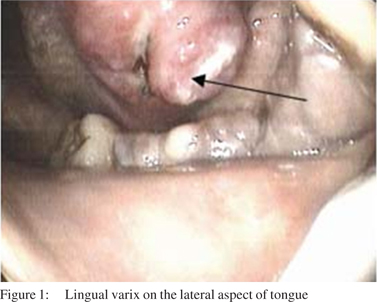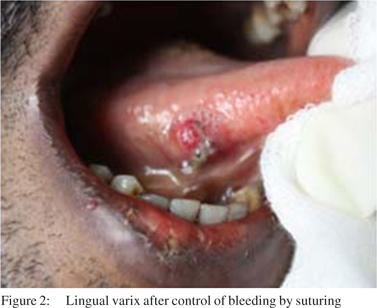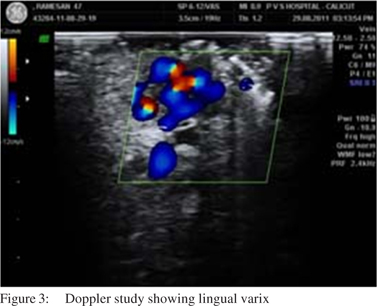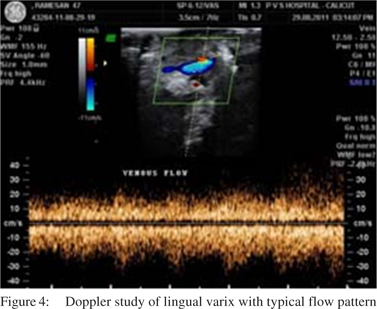48uep6bbphidvals|637
48uep6bbph|2000F98CTab_Articles|Fulltext
The association of lingual varix with portal hypertension and liver cirrhosis is rare. We report a patient with alcoholic liver cirrhosis who developed lingual varix followed by intermittent bleeding.
Case report
A 47-year-old male with alcoholic liver cirrhosis and portal hypertension of four years duration was admitted with history of spitting of fresh blood since one week. The patient gave history of a similar episode two months back which had stopped spontaneously, and of a bluish soft swelling on the inferolateral surface of the tongue since four months ago. Examination of oral cavity revealed presence of prominent, tortuous, bluish blood vessels (Figure 1). The patient complained of no discomfort or change in size of the lesion. His medical history did not reveal any blood dyscrasias. System examination and investigations including ultrasound revealed presence of liver cirrhosis and oesophago-gastro-duodenoscopy showed grade 2 esophageal varices. Chest X-ray did not reveal any SVC obstruction. Doppler study of lingual swelling showed it to be variceal in origin with dilated venous channels (Figures 2 and 3). Bleeding was controlled by suturing the varix (Figure 4).



 Discussion
A varicosity is an enlarged and tortuous vein, artery or lymph vessel with a purple to red appearance. Varicosities are related to age, tissue compromise and increased venous pressure. Oral varicosities are usually seen on the lateral border of the tongue and floor of the mouth, mostly in persons 40 years or above in age. They may occasionally be seen in cheeks and lips as well.[1] Ettinger and Mandersen found that the incidence of varicosities increases with age.[2] It was Koscard and coworkers who concluded that the diminished capillary elastic support which allowed them to dilate and lead to varicosity formation. Another report has showed sublingual varices to be associated with portal hypertension secondary to hepatic cirrhosis.[3] Varices formation can be explained by three reasons: firstly varices can arise spontaneously, unrelated to any systemic disease; secondly, they may be a manifestation of cardiopulmonary disease[4] and lastly, there may be an unrecognized anastomotic connection between the lingual venous drainage and portal circulation.
References
Discussion
A varicosity is an enlarged and tortuous vein, artery or lymph vessel with a purple to red appearance. Varicosities are related to age, tissue compromise and increased venous pressure. Oral varicosities are usually seen on the lateral border of the tongue and floor of the mouth, mostly in persons 40 years or above in age. They may occasionally be seen in cheeks and lips as well.[1] Ettinger and Mandersen found that the incidence of varicosities increases with age.[2] It was Koscard and coworkers who concluded that the diminished capillary elastic support which allowed them to dilate and lead to varicosity formation. Another report has showed sublingual varices to be associated with portal hypertension secondary to hepatic cirrhosis.[3] Varices formation can be explained by three reasons: firstly varices can arise spontaneously, unrelated to any systemic disease; secondly, they may be a manifestation of cardiopulmonary disease[4] and lastly, there may be an unrecognized anastomotic connection between the lingual venous drainage and portal circulation.
References
- Herbert Z, Klienmen, Danville. Lingual varicosities. Oral Surg. 1974;23:546–8.
- Ettinger RL, Manderson RD. A clinical study of sublingual varices. Oral Surg Oral Med Oral Pathol. 1974;38:540–5.
- Jassar P, Jaramillo M, Nunez DA. Base of tongue varices associated with portal hypertension. Postgrad Med J. 2000;76:576–7.
- Burket LW. Oral medicine. 4th ed. Philadelphia: JB Lippincott;1961.p.146.